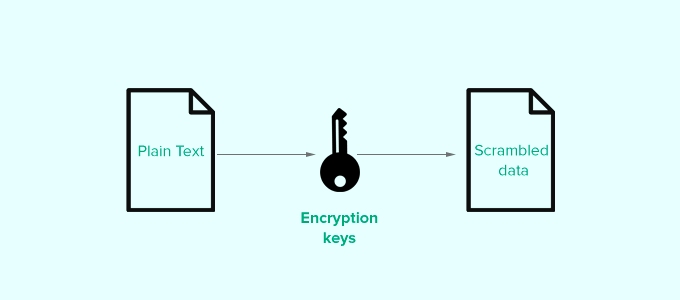When it comes to keeping your WordPress site secure, cryptographic keys play an essential role. These keys are like the secret codes that ensure only authorized users and systems can access certain parts of your site. Whether you’re protecting user data, managing transactions, or safeguarding login credentials, cryptographic keys offer a strong layer of defense. In this article, we’ll explore how adding cryptographic keys to your WordPress site can boost security and keep your data safe from cyber threats.
Understanding Cryptography and Its Role in Website Security

Cryptography is the practice of protecting information through encryption. By converting data into an unreadable format, it ensures that only those with the correct key can decipher it. This is particularly important for websites like WordPress, which handle sensitive data such as passwords, personal details, and financial transactions. Here’s why cryptography matters for website security:
- Data Encryption: Cryptography protects your data by making it unreadable to unauthorized users.
- Authentication: Cryptographic methods verify the identity of users or servers, ensuring that only trusted parties are interacting with your website.
- Integrity: Cryptography ensures that your data hasn’t been tampered with during transmission, preserving its integrity.
By using cryptographic techniques, you can strengthen your WordPress site’s defense against hackers and malicious actors. Without proper encryption, sensitive information could be exposed, putting both your site and users at risk.
How Cryptographic Keys Work with WordPress

Cryptographic keys are central to WordPress‘s security framework, especially when dealing with user authentication and secure communication. These keys come in pairs: a public key and a private key. Here’s how they work:
- Public Key: This is the key you share with others to encrypt data. It’s openly available, so anyone can use it to send secure messages to you.
- Private Key: This is kept secret and used to decrypt data encrypted with the public key. Only you or your website’s server should have access to it.
In WordPress, these keys are used for various purposes, including:
- SSL/TLS Certificates: These cryptographic keys help establish secure connections between your WordPress site and visitors, ensuring that all data exchanged is encrypted.
- Password Storage: WordPress uses cryptographic hashing algorithms to store passwords securely. Even if hackers gain access to your database, they won’t be able to retrieve the original passwords.
- API Integrations: Cryptographic keys are essential for securely communicating with external services and APIs, ensuring that data remains protected during exchanges.
WordPress also allows you to configure your site’s cryptographic keys manually through the wp-config.php file. This file includes security keys that are used for authentication and encryption across the platform.
Steps to Add Cryptographic Keys to a WordPress Site

Adding cryptographic keys to your WordPress site can enhance security by ensuring that sensitive information is protected from unauthorized access. Here’s a simple step-by-step guide to help you add these keys to your WordPress installation:
- Generate Cryptographic Keys: You can generate cryptographic keys using online tools or through command-line utilities. Tools like OpenSSL can help you create the key pairs (public and private keys).
- Access Your WordPress Configuration File: You’ll need to access your WordPress root directory and locate the wp-config.php file. This is where you’ll insert your cryptographic keys.
- Insert the Keys into wp-config.php: Open the wp-config.php file in a text editor and insert your keys. Look for the section that contains authentication unique keys and salts. You can add your generated keys here to ensure WordPress uses them for encryption.
- Save and Upload: After inserting the keys, save the wp-config.php file and upload it back to your WordPress site. Make sure the file permissions are set correctly for security.
- Verify Key Usage: To ensure the keys are being used correctly, you can test your site’s encryption methods. This can be done by checking your SSL certificate or reviewing the way your site handles login data.
By following these steps, you’ll have added an extra layer of security to your WordPress site, ensuring sensitive data remains encrypted and protected.
Benefits of Using Cryptographic Keys for WordPress Security
Integrating cryptographic keys into your WordPress site’s security system offers a variety of benefits, making your website more resilient to cyber threats. Here’s why using cryptographic keys is a smart move:
- Enhanced Data Security: Cryptographic keys ensure that sensitive data, such as user passwords and transaction details, are encrypted. This prevents unauthorized access, even if attackers intercept the data.
- Improved Authentication: With the use of public and private keys, you can verify users and systems before granting access to certain parts of your site, reducing the risk of unauthorized logins.
- Protection Against Data Tampering: Cryptography ensures that data remains intact while in transit. Even if a hacker intercepts data packets, they cannot modify or decrypt the content without the correct keys.
- Compliance with Security Standards: Using cryptographic keys can help you meet industry regulations and security standards, such as GDPR or PCI-DSS, which require encryption of sensitive data.
- Secure API Integrations: Cryptographic keys are crucial for secure communication with third-party services. By using keys to authenticate APIs, you can ensure that your integrations are safe and reliable.
Incorporating cryptographic keys into your WordPress site is an investment in long-term security, helping you build trust with your visitors and protect your site from malicious attacks.
Common Cryptographic Techniques for WordPress Sites
There are several cryptographic techniques you can use to boost your WordPress site’s security. These methods are designed to protect sensitive data, improve authentication, and ensure the integrity of your site’s communication. Let’s look at the most common techniques:
- SSL/TLS Encryption: SSL (Secure Sockets Layer) and TLS (Transport Layer Security) are the most commonly used protocols for encrypting data between a web server and a user’s browser. Implementing SSL on your WordPress site helps protect all data transmitted, such as login details, payment information, and personal data.
- Password Hashing: WordPress uses cryptographic hashing to store passwords securely. Instead of storing plain text passwords, WordPress hashes them using algorithms like bcrypt, making it nearly impossible for hackers to retrieve the original password.
- Public/Private Key Encryption: This technique involves the use of a key pair—one public and one private. The public key encrypts the data, while the private key is used to decrypt it. This is useful for API authentication and secure communication between services.
- Digital Signatures: A digital signature is used to verify the authenticity of a message or document. In WordPress, digital signatures are often used to verify the integrity of plugins and themes before installation, ensuring they haven’t been tampered with.
- Two-Factor Authentication (2FA): While not strictly a cryptographic method, 2FA combines cryptographic techniques with an additional layer of security. By requiring users to provide both a password and a second factor (like a code sent to their phone), it ensures that even if a password is compromised, unauthorized users cannot access the site.
By applying these cryptographic techniques, you can ensure your WordPress site is well-protected from security threats, keeping both your data and your users’ data safe.
Challenges of Implementing Cryptographic Keys
While adding cryptographic keys to your WordPress site offers strong security benefits, there are a few challenges you may encounter. Implementing cryptography requires a solid understanding of encryption techniques and proper configuration. Below are some common obstacles:
- Complex Setup: Setting up cryptographic keys can be tricky, especially if you’re unfamiliar with the technical aspects. You need to generate the keys correctly, configure your server to use them, and ensure they are stored securely.
- Performance Overhead: Encryption and decryption processes can consume server resources. If your WordPress site has high traffic, this can impact performance, especially for real-time operations like API calls and login verification.
- Key Management: Properly managing cryptographic keys is crucial. If a key is lost or compromised, it can break the security of your site. You’ll need to securely store the keys and rotate them periodically to maintain security.
- Compatibility Issues: Some older plugins or themes may not support modern cryptographic techniques, which could cause compatibility issues. It’s important to ensure that your entire WordPress setup, including third-party tools, supports the cryptography methods you implement.
- Cost of Implementation: If you’re using third-party services for key management or SSL certificates, there may be associated costs. While many hosting providers offer free SSL certificates, advanced encryption methods or enterprise-level solutions can become expensive.
Despite these challenges, the benefits of implementing cryptographic keys far outweigh the difficulties, and with proper planning and implementation, these obstacles can be overcome.
Conclusion and Key Takeaways
Incorporating cryptographic keys into your WordPress site is a highly effective way to bolster security and protect sensitive data from cyber threats. By understanding the role of encryption, authentication, and key management, you can significantly reduce the risk of attacks like data breaches and unauthorized access. Here’s a quick recap of the key takeaways:
- Data Protection: Cryptographic keys help encrypt and protect sensitive information, such as passwords and personal data, from unauthorized access.
- Authentication and Integrity: Keys verify the identity of users and ensure that data remains unaltered during transmission.
- Practical Implementation: Adding cryptographic keys to your site involves generating the keys, configuring your WordPress setup, and managing them securely to avoid performance and compatibility issues.
- Long-Term Security: By integrating these keys, you enhance your site’s ability to prevent cyber-attacks and comply with security regulations.
Ultimately, while the process of setting up cryptographic keys may have some technical hurdles, it’s a crucial step toward a more secure WordPress site. Taking action now will help safeguard your site’s future and protect your users’ data.
FAQ
1. What are cryptographic keys?
Cryptographic keys are pairs of algorithms used for encryption and decryption. The public key encrypts data, while the private key is used to decrypt it. These keys are essential for securing data on your WordPress site, especially for sensitive information such as passwords and transactions.
2. How do I add cryptographic keys to my WordPress site?
You can add cryptographic keys to your WordPress site by generating the keys using a tool like OpenSSL, then inserting them into the wp-config.php file of your WordPress installation. This allows WordPress to use these keys for encryption and secure authentication.
3. Is it necessary to use cryptographic keys for all WordPress sites?
While not strictly necessary for all sites, using cryptographic keys is highly recommended for sites that handle sensitive data, such as e-commerce sites or membership sites. Implementing cryptography will strengthen security and protect your users’ personal information.
4. What happens if a cryptographic key is compromised?
If a cryptographic key is compromised, the security of your site could be at risk. It’s essential to rotate keys periodically, store them securely, and monitor for any unauthorized access. In the case of a breach, you should replace the compromised key immediately to restore security.
5. Can cryptographic keys affect the performance of my WordPress site?
Yes, cryptographic operations like encryption and decryption can consume server resources. If your site has high traffic or complex encryption methods, it may cause performance slowdowns. It’s important to optimize your server and use efficient encryption techniques to minimize the impact.



